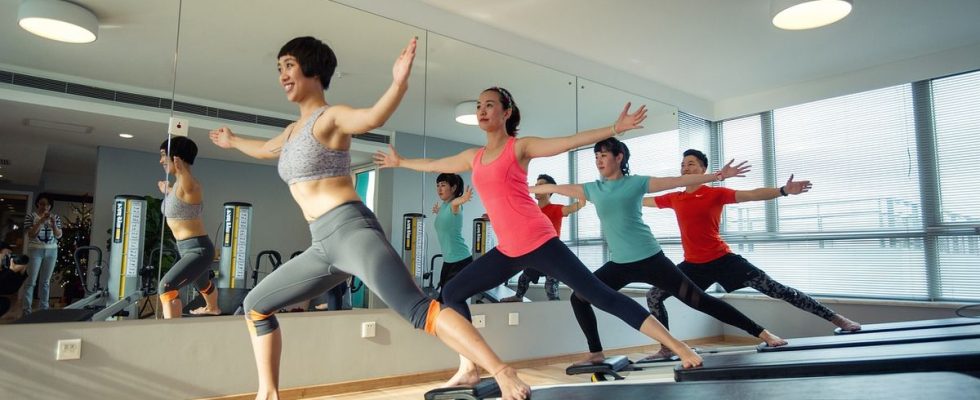THE Pilates continues to reinvent itself and we can quickly get lost in its multiple names… Which practice should you choose? Which one best meets your expectations? To help you see more clearly, 20 minutes asked Lugdivine Meytre, author of the book Pilates your life to First editions, and to Aurélie, Pilates coach at Poses Studio, to compare different forms of popular Pilates.
Despite their slight nuances, they keep the same common core: the classic Pilates method founded by Joseph Pilates, whose objective is to soothe the ills of modern life, stress in particular, by working, in full awareness of one’s body, the deep muscles, flexibility, breathing and posture. It’s less about strengthening your muscle mass than about “gaining energy”, “positivity”, and “having fun”.
The Pilates Reformer, to be more toned
Pilates Reformer owes its name to the mobile equipment it requires. “It’s an unstable machine which makes the exercises more complex,” explains coach Aurélie to 20 minutes. When standing on a sliding machine, you concentrate more on your balance so as not to fall. This variant puts a lot of strain on the muscles and therefore allows you to maintain good muscle mass, provided you have a good diet.
For who ? People who like to challenge themselves and gain strength but who are less fans of traditional bodybuilding. The Reformer machine has levers of different resistances and different loads in order to progress at your own pace. “The advantage of this machine is that you can adapt it to your level,” emphasizes Aurélie.
Stott Pilates or contemporary Pilates, to improve your posture
It can be seen as an extension of the classic Pilates method. We will still be interested in posture and strengthening the deep muscles but by adding additional, slower and controlled movements. “The Joseph Pilates method is still 100 years old, here we will have an even more scientific look because the research is more in-depth,” explains the Poses Studio coach.
For who ? A practical variation if you are already a fan of the traditional Pilates method or simply want to be more in tune with your body, in particular thanks to work on posture and more specifically on the spine.
Power Pilates or modern Pilates, to work on cardio
“There are important and complementary cardio movements with this technique, which is the big difference compared to other Pilates,” explains the author of Pilates your life. Power Pilates is therefore one of the most intense derivatives because it will require more physical effort, such as doing squats or core exercises or using accessories such as straw balls.
For who ? Those who want to have even more feelings during their sessions, and of course fitness enthusiasts who would like to discover Pilates in a more physical version.
Hot Pilates, to burn calories more easily
The goal here is to sweat. For this, classes are held in rooms heated to between 32 and 35°C. We are therefore dealing with a technique which “pushes the body to its limits”, explains the author Lugdivine Maytre.
For who ? A public who is used to doing sports and who is not afraid to sweat. However, be careful with seniors and pregnant women. “If you don’t have a good heart condition, hot Pilates is a bit of a hardcore method,” warns the author of the book. This variation is also “more fitness”, adds coach Aurélie. And therefore requires effort to concentrate and work on your breathing.

